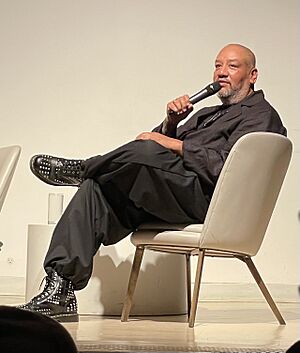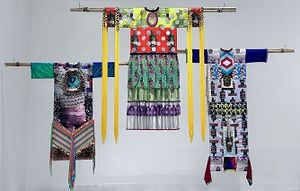Jeffrey Gibson facts for kids
Quick facts for kids
Jeffrey Gibson
|
|
|---|---|

Gibson speaking at the Hirshhorn Museum in 2024
|
|
| Born | March 31, 1972 Colorado Springs, Colorado, U.S.
|
| Nationality | Mississippi Choctaw, United States |
| Education | School of the Art Institute of Chicago, Royal College of Art |
| Known for | Painting, sculpture |
| Spouse(s) | Rune Olsen |
Jeffrey A. Gibson, born in 1972, is a talented American artist. He is known for his amazing paintings and sculptures. Jeffrey Gibson is a member of the Mississippi Choctaw and Cherokee tribes. He has lived and worked in different places in New York. In 2024, he made history by representing the United States at the Venice Biennale. He was the first Indigenous artist to have a solo show there.
Contents
Early Life and Education
Jeffrey A. Gibson was born on March 31, 1972. His birthplace was Colorado Springs, Colorado. His mother is from the Cherokee Nation. His father was a citizen of the Mississippi Band of Choctaw Indians. His parents grew up in difficult conditions. They both attended boarding schools for Native American children.
As a child, Gibson moved around a lot. He lived in North Carolina, New Jersey, West Germany, and South Korea. This was because his father worked for the United States Department of Defense.
Learning to Be an Artist
Gibson earned his first art degree in 1995. He studied at the School of the Art Institute of Chicago. In 1998, he received his master's degree from the Royal College of Art in London. There, he focused on painting. The Mississippi Band of Choctaw Indians helped pay for his education. Gibson said about this help, "My community has supported me... My chief felt that me going there, being a strong artist, made him stronger."
Gibson is married to Norwegian artist Rune Olsen. They have a daughter and a son together.
Jeffrey Gibson's Art Career
Gibson is currently an artist and teacher at Bard College. He teaches studio art classes there. In 2010, he was a visiting artist at the California College of the Arts.
Gibson likes to work in his studio from 10 AM to 6 PM. He often has music playing in the background. He listens to many different types of music. These include African funk, jazz, punk, pop, rap, R&B, and disco.
What His Art Is About
Gibson's art often explores ideas about identity. His works use many different materials. These include Native American beadwork and traditional blankets. He also uses metal studs, fringe, and jingles.
Airbrushing is another tool he uses often. He creates bright, abstract paintings and sculptures. Examples include Singular (2008) and Submerge (2007). These works are also inspired by graffiti from his life in New York City.
Representing the U.S. at Venice
In 2024, Gibson represented the United States at the Venice Biennale. This is a very important art event. His solo exhibition was called The Space in Which to Place Me. The title came from a poem by Layli Long Soldier.
His art in this show talked about politics and American history. It included paintings, sculptures, flags, videos, and beadwork. All these pieces used bright, exciting colors. He was the first Indigenous artist to have a full exhibition for the United States at the Venice Biennale.
Influences on His Art
Gibson gets ideas from many different places. He is inspired by various materials, art methods, and symbols. He finds inspiration in dancing events. These include Leigh Bowery's dramatic nightclub performances.
Pow-wows, nightclubs, and raves also inspire him. These are different places for dancing and movement. They also feature amazing fashion and outfits. He is also inspired by 19th-century Iroquois beadwork. Colorful beads often appear in his artworks. Gibson also adds his own style to graffiti in his pieces.
How His Life Shapes His Art
His childhood, where he moved often, also influences him. He says this "nomadic" lifestyle brings together different styles. He explains that these differences flow through him. He sees himself as a "queer Native male" living in the 21st century. He uses this mix of experiences to create his complex art.
Jeffrey Gibson's Artworks
Rawhide Painting Series
Gibson often paints with oil and acrylic on rawhide. Rawhide is animal skin that has not been tanned. He uses found objects like old mirrors and ironing boards. He covers them with deer, goat, or elk skin. His art combines everyday objects with Native American and modern art styles.
For example, he made a punching bag from old Everlast bags. He added U.S. Army wool blankets, glass beads, and tin jingles. This piece shows how he mixes pop culture with Native American powwow styles. His work Document, 2015 (2015) uses deer rawhide and steel spikes. Under Cover (2015) was made with rawhide stretched over wood.
"Atmospheric Landscapes"
Before his more recent works, Gibson created "atmospheric landscapes." These were sometimes 3-D wall art. He used oil paint and other materials like silicon, urethane foam, and beads. These materials became a special part of his art.
Alive (2017)
His artwork Alive was shown in 2017. It was part of the Desert x exhibition. This exhibition took place in the Coachella Valley.
Totems Series
In 2009, Gibson created his Totems series. These were sculptures for an exhibition in Texas. He arrived five days early to find objects for them. He used things like mannequins, wigs, plastic flowers, toys, cowboy boots, and flower pots. He also used his signature spray paint.
He created two human-like figures and a totem pole from flower pots. One writer said Gibson used stereotypes of his own people. He did this to explore how identity is formed. He also looked at culture and consumerism in his art.
Notable Art Collections
Many museums and art centers own Gibson's artworks. Some of these include:
- Crystal Bridges Museum
- Denver Art Museum
- Hood Museum
- Nasher Museum of Art
- Nerman Museum of Contemporary Art
- Mississippi Museum of Art
- Museum of Fine Arts, Boston
- Eiteljorg Museum of American Indians and Western Art
- Philbrook Museum of Art
- Smithsonian Institution, National Museum of the American Indian
- School for Advanced Research
- Speed Art Museum
- Whitney Museum of American Art
Notable Exhibitions
Gibson's art has been shown in many important exhibitions:
- This Burning World, 2022, Institute of Contemporary Art San Francisco, California
- Stretching the Canvas: Eight Decades of Native Painting (2019–2021), National Museum of the American Indian, New York
- Jeffrey Gibson: This Is the Day, 2018–19, Ruth and Elmer Wellin Museum of Art, New York, and Blanton Museum of Art, Texas
- Jeffrey Gibson: Like A Hammer, 2018–19, Denver Art Museum, Colorado, Mississippi Museum of Art, Mississippi, Seattle Art Museum, Washington, and Madison Museum of Contemporary Art, Wisconsin
- Sakahan, 2013, National Gallery of Canada, Ontario
- Said The Pigeon to the Squirrel, 2013, National Academy Museum and School, New York
- Love Song, 2013, Institute of Contemporary Art, Boston, Massachusetts
- Tipi Poles Performing As Lines, 2013, Cornell Fine Arts Museum, Florida
- Marc Straus, 2012, New York
- Shapeshifting, 2012, Peabody Essex Museum, Massachusetts
- Changing Hands 3, 2012, Museum of Arts and Design, New York
- Recent Acquisitions, 2011, Denver Art Museum, Colorado
- Recent Acquisitions, 2011, Museum of Fine Arts, Boston, Massachusetts
- Collision, 2010, Rhode Island School of Design, Rhode Island
- Vantage Point, 2010, National Museum of the American Indian, Washington, DC
- Flushing Town Hall Projects, 2008, Flushing Town Hall, New York
- Group show, 2008, Kentler International Drawing Space, New York
- Voices From the Mound, 2008, IAIA Museum of Contemporary Arts, New Mexico
- Group show, 2007, New England School of Art and Design, Massachusetts
- Off the Map, 2007, National Museum of the American Indian, New York
- SONOTUBE, 2007, Santa Barbara Contemporary Arts, California
- BROOKLYN, 2006, Westport Arts Center, Connecticut
- No Reservations, 2006, Aldrich Contemporary Art Museum, Connecticut
- Paumanok-a, 2006, Stony Brook University, New York
- Tropicalisms, 2006, Jersey City Museum, New Jersey
- Indigenous Anomaly, 2005, American Indian Community House, New York
- (re)positions, 2001, Bronx Museum of the Arts, New York
Gibson has also shown his work at many art fairs and galleries.
Notable Awards and Grants
Jeffrey Gibson has received many important awards for his art:
- MacArthur Fellowship, 2019
- Joan Mitchell Foundation Painters and Sculptors Grant, 2012
- TED (conference) Foundation Fellow, 2012
- Smithsonian Institution Contemporary Arts Grant, 2012
- Jerome Hill Foundation, 2012
- Eiteljorg Museum Fellowship for Native American Fine Art, 2009, Eiteljorg Museum of American Indians and Western Art
- Ronald & Susan Dubin Fellowship, 2008, School for Advanced Research


